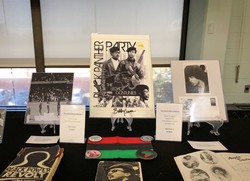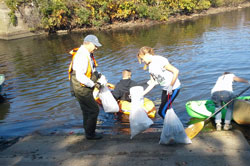“A Tribute to The African- American Journey,” a traveling museum which displays artifacts from significant moments in African American history and culture, made a stop in the Rebecca Stafford Student Center, Anacon B, on Feb. 21.
Displayed artifacts ranged from many culturally important civilizations in Africa, as well as through the Transatlantic Slave Trade, Slavery, The Civil War, Reconstruction, The Jim Crow Era, The Civil Rights and Black Power Movements, and through to the modern day. The collection also celebrates and highlights contributions of African Americans in the arts, sciences, sports, entertainment, politics and education.
Fred Saffold, Community Outreach Coordinator for The True Black History Museum, explained the personal connection he feels with all artifacts of the traveling collection.
“I don’t have one particular favorite piece, because everything is of significant importance,” Saffold said. “However, I’d say the Jim Crow [section] is important because I feel like that area of history and time has had the most impact. That false narrative of African Americans still resonates in the world to this day.”
Artifacts contained within the Jim Crow era collection included self-addressed mailing envelopes of Thelms “Butterfly” McQueen, an African American actress who was best known for her starring role in the 1939 film “Gone With The Wind” as Prissy, a maid, as well paraphernalia from the Klu Klux Klan, a U.S. white supremacist hate group whose primary target was African Americans.
“It makes me feel empowered,” Saffold said. “It makes me feel like we’re doing this work for a reason. Our goal here is to bring back value to people of African descent, so seeing this false narrative, living through it, surviving it, protesting against it and seeing some progression, it’s amazing. The mission is to restore value to people of African descent, in the black community and outside.”
Zaneta Rago-Craft, Director of the University Intercultural Center, explained her love for the political components of the traveling museum’s collection.
“I really like the Shirley Chisolm piece because I think that her history, specifically as a potential candidate for president, is lost in history a lot,” Rago-Craft said. “She was just such a powerhouse and I think it’s cool for people to be able to experience a lot of her story, especially with the presidential election coming up.”
Rago-Craft was referring to a signed article by Shirley Chisholm, the first African American woman elected to the U.S. congress, as well as becoming the first woman to run for Democratic presidential nomination in 1972. This item sits alongside a signed photo of President Barack Obama.
Janay Craft, Director of Operations for True Black History Museum, expressed interest in adding more modern items to the collection.
“I definitely would like to add more modern stuff, as there are activists and people that are making history right now,” Craft said. “With Kobe Bryant’s recent passing, I would love to get some artifacts of his. There’s so many artifacts you could collect, but off the top of my head it would be more modern things that are happening now, and the legendary Kobe Bryant.”
A sports related table includes a signed pamphlet by African American boxer, activist and philanthropist Muhammad Ali, as well as a signed jersey by Martin Briscoe, the first starting African American quarterback in professional football. A signed card by Kareem Abdul Jabbar, an activist and retired hall of fame basketball player who played 20 seasons in the NBA, is also included in the collection.
Jihad Johnson, student advising mentor and representative of the Intercultural Center, reflected on the American educational system’s inability to properly convey African American history.
“As a student, to realize how much you weren’t taught as a kid, and then to come in [to the traveling museum] and see so much, you feel robbed almost,” Johnson said. “You’re like ‘wow, this is so much history with so much to know, and so many interesting things that people like me have done,’ and I was never taught it. I have to learn all this information through museums and things like that. This information should be in textbooks; it’s something I should be learning and taking exams on growing up as a kid, especially as a black man.”
PHOTOS TAKEN by Matthew Cutillo




